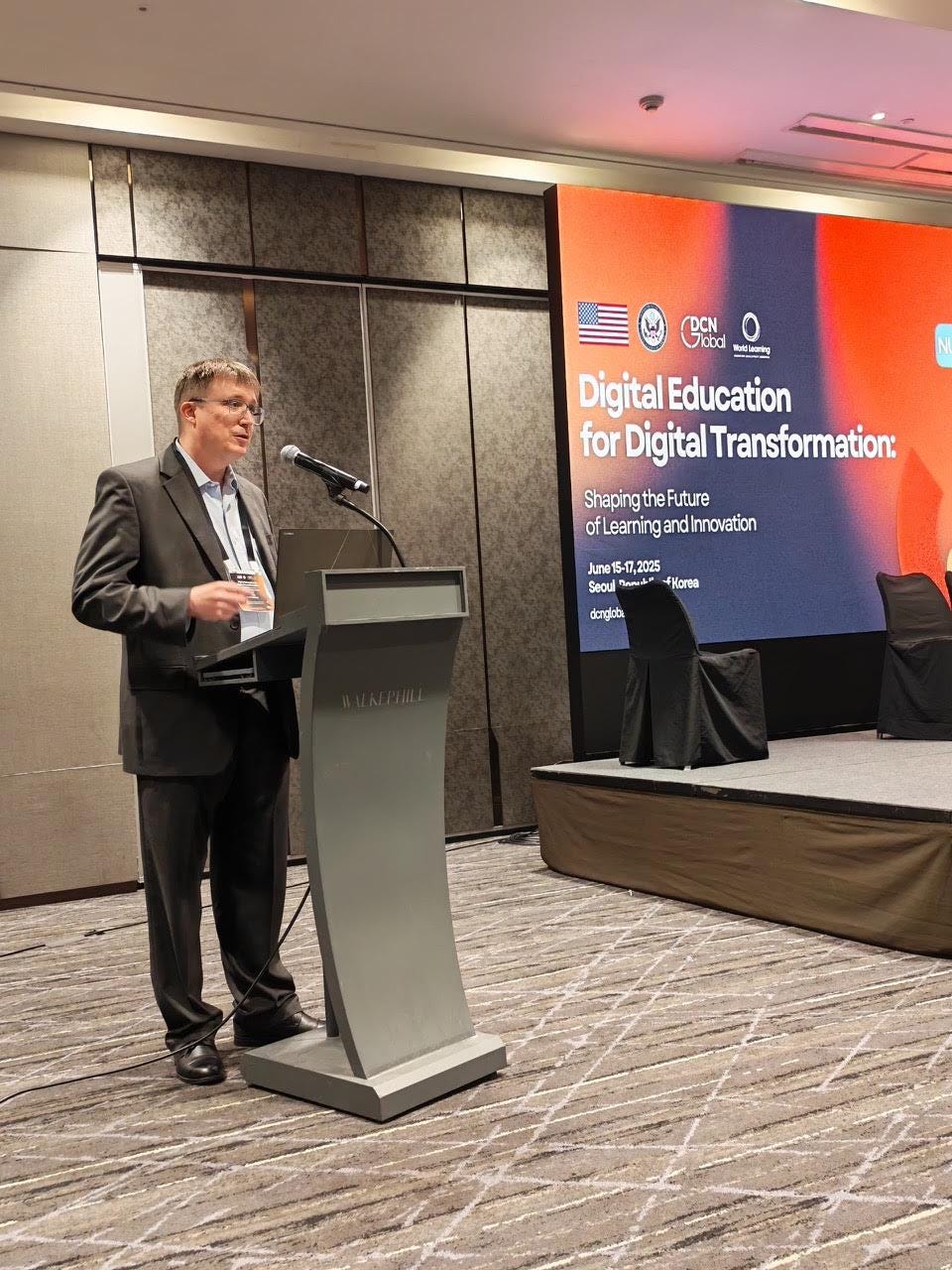Beyond Tool Proficiency: Reflections on AI Implementation in Southeast Asia
A conference experience reveals stark contrasts between systematic and reactive approaches to educational AI integration
The Tale of Two Integration Models
Sitting in a conference room in Seoul, surrounded by educators from Malaysia, Cambodia, Vietnam, Laos, Thailand, and Singapore, I witnessed something profound: two fundamentally different approaches to AI integration in education emerging across the global landscape. The contrast couldn't have been starker—or more instructive.
On one side, there's the U.S. model: reactive, feelings-based, and perpetually bouncing between the latest AI breakthrough and the next moral panic. Each new research paper, each viral post about AI capabilities, sends ripples through our educational discourse. We lurch from excitement to caution to excitement again, with little systematic foundation beneath the waves of sentiment.
On the other side, I observed something different—particularly in South Korea's approach, but evident in varying degrees across Southeast Asia: a systematic, infrastructure-first mentality that prioritizes long-term transformation over short-term reactions.
The South Korean Systematic Advantage
South Korea's approach reveals what systematic AI implementation looks like in practice—and what it costs. While we in the U.S. debate whether to ban ChatGPT or celebrate it, South Korea has been methodically building the foundations for AI-enhanced education with unprecedented financial commitment. The government has earmarked $69.3 million through 2026 just for digital classroom infrastructure, plus another $43.2 million to establish AI textbook monitoring systems in 6,000 schools and train 1,200 digital tutors. Most remarkably, they've budgeted roughly ₩1 trillion (US$740 million) over 2024-2026 specifically for teacher capacity-building in AI integration.
Compare this to the typical U.S. approach: vaguely written federal directives encouraging districts to "develop AI plans" with little to no dedicated funding to support systematic implementation. Our states and districts are left to chase fragmented grant opportunities while South Korea commits three-quarters of a billion dollars just to teacher training.
But this isn't just about having more government funding—it's about recognizing that meaningful AI integration requires transformation at the system level, not just adoption at the classroom level. South Korea's infrastructure investments include ensuring every student has a device by 2025, upgrading school Wi-Fi and servers to handle data-intensive AI applications, and deploying dedicated IT support staff in every district. Meanwhile, their Ministry of Education doesn't chase the latest AI trend; it builds systematic capacity for teachers to engage with AI as part of a coherent pedagogical vision backed by sustained financial commitment.
The results speak for themselves. The systematic preparation is evident in outcomes like the 73% of students showing significant improvement in AI-powered math platforms within 3-6 months, as independently verified by teachers. This isn't happening because of individual teacher heroics, but because of systematic infrastructure, training, and support.
Southeast Asia's Spectrum of Readiness
But South Korea represents just one point on a spectrum I encountered throughout the region. The educators I met from Malaysia, Vietnam, Thailand, and Singapore each brought stories of their countries' evolving approaches—some more systematic, others still building foundational capacity.
What struck me wasn't the variation in resources or infrastructure, though those differences are real and significant. It was the shared recognition that AI integration in education requires intentional preparation, not just enthusiastic adoption. Even in countries like Cambodia, where digital infrastructure remains a challenge, there's a clear-eyed understanding that effective AI use demands careful planning, teacher preparation, and systematic implementation.
This stands in marked contrast to what I see in many U.S. contexts, where AI adoption often feels like a series of individual experiments—some brilliant, some disastrous, most somewhere in between—with little systematic learning or scaling.
The other predominant story I encountered was one of deepening need for funding in countries that have less systematic approaches for resources and training. But by contrast with the U.S., there is a recognized need to move forward and a deepening knowledge base as to how to affect change—just not currently matched by investment and capital.
The Hunger for Deeper Literacy
Throughout the conference, my presentations on AI literacy that goes beyond tool proficiency were excitedly received. There is real interest in the region in approaches to AI literacy that push beyond instruction of tool proficiency. As in the U.S., there is a hunger for approaches that help students develop expertise, preserve memories, develop cognition through AI interactions.
This hunger revealed something important: the question isn't just how to use AI tools, but how to think with and about AI in ways that enhance rather than diminish human capacity. The educators I met understand intuitively what research is beginning to confirm—that effective AI collaboration requires sophisticated skills in reasoning, evaluation, reflection, and creative synthesis.
The Critical Question: What Do We Really Need to Know?
The one resounding question that I came away with—and challenged my audiences to consider—is deceptively simple: What do we really need to know in order to work effectively with these systems? Answers will be different across the developmental spectrum, but for me the crucial question is what do K-12 audiences need to know.
I encountered two camps in trying to answer this question. There was trust among some of the techno-futurists in the conference room that the knowledge will emerge organically through use—or not—that the pace of change is too rapid right now to answer this question in a definitive way. These persons predict a full-scale shift in educational contexts to AI-infused writing.
But when I would sit down with some of the techno-futurists and pushed at the paradigm a bit, I sensed some real discomfort in the highly emergent nature of this proposition. There's something unsettling about betting our students' futures on the hope that essential skills will simply emerge through exposure.
I suggested that prompting skills are just the tip of the iceberg. That the domains of knowledge are as of yet unclear—but perhaps as large as the skillset and better yet, mindset, our traditional methods try to cultivate in children—adaptability, actionable memory sets, communication skills, rhetorical awareness, ability to collaborate, empathy, resilience—and yet so consistently fail to do so.
The difference is that AI creates new contexts and new urgency around these perennial educational goals. Students need these capacities not just for academic success, but for the kind of thoughtful, intentional AI collaboration that enhances rather than replaces human judgment.
Lessons for U.S. Education
The systematic approaches I witnessed in Southeast Asia offer important lessons for U.S. educators and policymakers grappling with AI integration:
Financial Commitment Drives Systematic Change: South Korea's $740 million investment in teacher training alone dwarfs most U.S. state education technology budgets. While American policymakers issue directives for districts to "develop AI strategies," they rarely provide the funding needed for systematic implementation. The result is a patchwork of individual initiatives rather than coherent transformation.
Infrastructure First: Meaningful AI integration requires systematic attention to teacher preparation, technological infrastructure, and curricular alignment. South Korea's commitment to universal device access, upgraded networks, and dedicated IT support staff creates the foundation for sustainable AI integration. Individual classroom innovations, while valuable, can't substitute for system-level planning and investment.
Beyond Tool Training: The most sophisticated approaches focus on developing students' capacity for critical thinking, metacognition, and collaborative reasoning—skills that make AI use more intentional and effective. Vietnam's National AI in Education Forum explicitly emphasized moving beyond basic prompt engineering to develop what they call "AI competency frameworks" that encompass ethical reasoning, data literacy, and the ability to evaluate AI outputs critically. This mirrors what I heard repeatedly from educators across the region: hunger for approaches that cultivate deeper cognitive capacities rather than surface-level tool familiarity.
Long-term Vision Over Trend-Chasing: Rather than reacting to the latest AI development, successful programs build toward coherent visions of how AI can enhance teaching and learning over time. Singapore's measured approach exemplifies this—they didn't rush to deploy ChatGPT in classrooms but instead developed comprehensive guidelines for "wise and supervised" AI use while expanding their proven adaptive learning systems. Their AI literacy initiative targets 2026 for full implementation, reflecting commitment to systematic preparation rather than reactive adoption.
Shared Recognition of Necessity: Perhaps most importantly, the educators I met across Southeast Asia share a recognition that moving forward with AI integration isn't optional—it's necessary. Even in countries like Cambodia, where digital infrastructure remains challenging, there's clear commitment to building foundational capacity rather than waiting for perfect conditions. This contrasts sharply with the U.S. tendency to treat AI integration as optional or to implement moratoriums when challenges arise. The question across Southeast Asia isn't whether to engage with AI, but how to do so thoughtfully and systematically despite resource constraints.
Nick Potkalitsky, Ph.D.
Check out some of our favorite Substacks:
Mike Kentz’s AI EduPathways: Insights from one of our most insightful, creative, and eloquent AI educators in the business!!!
Terry Underwood’s Learning to Read, Reading to Learn: The most penetrating investigation of the intersections between compositional theory, literacy studies, and AI on the internet!!!
Suzi’s When Life Gives You AI: A cutting-edge exploration of the intersection among computer science, neuroscience, and philosophy
Alejandro Piad Morffis’s The Computerist Journal: Unmatched investigations into coding, machine learning, computational theory, and practical AI applications
Michael Woudenberg’s Polymathic Being: Polymathic wisdom brought to you every Sunday morning with your first cup of coffee
Rob Nelson’s AI Log: Incredibly deep and insightful essay about AI’s impact on higher ed, society, and culture.
Michael Spencer’s AI Supremacy: The most comprehensive and current analysis of AI news and trends, featuring numerous intriguing guest posts
Daniel Bashir’s The Gradient Podcast: The top interviews with leading AI experts, researchers, developers, and linguists.
Daniel Nest’s Why Try AI?: The most amazing updates on AI tools and techniques
Jason Gulya’s The AI Edventure: An important exploration of cutting-edge innovations in AI-responsive curriculum and pedagogy.






The post doesn't mention Taiwan, which also has huge investment into AI. At my daughter's public school, they have computer classes that have access to a government AI education platform. They are actively taught how to use it. But that's a class in the school. Otherwise, phones are forbidden on school property. If there's a problem or emergency, I have to call the school. This is standard across the region. I'm not sure how well that would go over in the USA. But more significantly, like South Korea, there is huge investment in education. The math curriculum is extremely well thought out, and schools guard access to all kinds of activities. It's not just a matter of money. Schools are this way because voters think it is important. I'm not sure that anything like these Asian experiments is possible in the USA.
Also wanted to add the UNESCO main source for "shared memories" - https://www.unesco.org/en/articles/future-collective-memory-preserving-past-digital-age?hub=1081